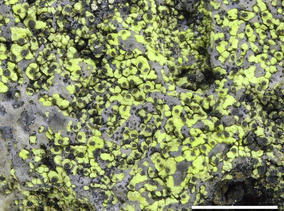You are here
Taxon Pages
Buellia sulphurica Bungartz & Aptroot
Nomenclature
-
Family: CaliciaceaeGenus: Buellia
SUMMARY
Mycobank MB 517738
Thallus crustose, thin, of dispersed groups of areoles, marginal ones ± subsquamulose, epilithic; prothallus absent; thallus surface matt, bright neon yellow, finely whitish pruinose, phenocorticate; thallus densely filled with fine crystals (ca. 5 µm in diam., dissolving in 10% KOH), and few large mineral crystals (irregular in diam., ca 30–50 µm, not dissolving). Apothecia lecideine, initially inconspicuously lecanorine; (0.10–)0.15–0.25(–0.30) mm in diameter; soon adnate to sessile; proper margin black, soon excluded, when emerging typically covered by coarse, thick thalline fragments; disc black, epruinose, initially plane, but soon strongly convex; thalline exciple, if present, poorly developed and reduced to very few adglutinated hyaline hyphae densely packed with photobiont cells, ± merging with the surrounding thallus; proper exciple similar to the aethalea-type sensu Scheidegger (1993), but strongly reduced to few, parallel hyphae, almost indistinct from the paraphyses, apically moderately swollen (textura oblita) and reddish brown (cf. elachista-brown, HNO3–), pigmentation continuous with the epihymenium; excipular hyphae downward soon losing pigmentation and not clearly differentiated from either hymenium or hypothecium, hymenium hyaline, not inspersed with oil droplets; paraphyses simple to moderately branched, apically swollen, with a brown pigment cap (cf. elachista-brown). Asci 8-spored, clavate, Bacidia-type. Ascospores oblong, not constricted with age, with obtuse ends, not curved, (9.8–)10.7–[12.1]–12.7(–13.7) x (5.9–)6.0–[6.6]–6.7(–6.8) µm (n = 25), 1-septate, proper septum briefly thickened during spore ontogeny (Physconia-type); ornamentation absent (not visible in DIC). Pycnidia not found. Secondary chemistry: rhizocarpic acid; thallus P–, K–, C–, KC–, CK–; thallus surface and medulla not amyloid (always test with concentrated Lugol's iodine or in the compound microscope; thallus reactions can be very weak!), the hymenium reacts amyloid in Lugol's.




